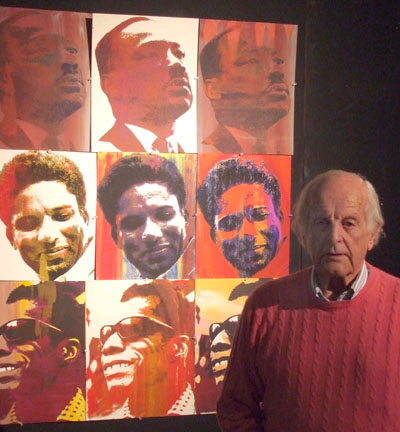
Frazer Dougherty with his Earth Cores. Photo by Joe Strand
Frazer Dougherty Celebrates Art Career Spanning Over 40 Years
By Eileen Casey in Hampton.com
archive article, added 11/12/2007

Frazer Dougherty with his Earth Cores. Photo by Joe Strand
East Hampton - Frazer Dougherty, well-known businessman, auteur, and social presence in the Hamptons, threw a solo exhibition, “Earth Cores”, and celebration at East Hampton Studios on Saturday, Nov. 10, from 5 p.m. to 10 p.m. in celebration of his artwork spanning over 40 years.
Born in 1922 in Wyncote, PA, it was during his six years as a pilot flying B-25 planes in New Guinea during WWII that he first began photographing earth patterns. Additionally he helped design, test-fly and develop the world’s first (FAA approved) auto-plane, the Airphibian. During this period of time he began experimenting with half-tone screens of aerial photographs, and created seragraphs, photographs, films, and silkscreens. His prior exhibitions include the Benson Gallery and the FAR Gallery. This exhibition includes all work from, during and immediately following his military career up through 1983.
What is the time period that tonight’s work represents?
FD: “This is almost everything I’ve done in the art world, including some films. I started after the war, in the late 40s, early 50s as a pilot looking out the window and seeing patterns that I photographed. I kept doing that and most of these pieces are what I call ‘earth cores’, that show patterns of sea, surf and land".
Is tonight’s exhibition a full representation of archival pieces?
FD: “It’s everything I have that was either framed or unframed. I have some paper pieces here for people to leaf through".
 Photo by Joe Strand |
 Frazer with "Selma". Photo by Joe Strand |
FD: “I like them [art pieces], the 100-foot long silkscreen was interesting to me for me to do because it was a challenge, I did it on three different materials, and while I had that screen on the table, I would do individual screens also, so it’s a 300-foot long job, and a bunch of prints. That’s a Greek panorama, and I spent a lot of time in Greece".
Is that a particular part of the world you are fond of?
FD: “Very".
Do you think you have any advice for struggling artists nowadays?
FD: “I think the main thing for anybody is just do it. You have to get in there and find out if you like it, and if you do, put it aside, and if you don’t, throw it away".
Are there any particular artist(s) you have been fortunate enough to work or collaborate with, or just simply admire?
FD: “Well, that’s a difficult question. I have a few pals that I worked with, Arnold Hoffman, is a silkscreener, and he and I collaborated a bit; Jimmy Ernst, who was next door here - I’m not an artist like many of the artists out here and that may be because I dropped it to run the public access television".
Have you missed it?
FD: “Yes, but it’s hard work, and you are working for yourself".
Are there any local artists here in the Hamptons whose work you have taken particular note of?
FD: “Again, I haven’t really been deeply involved in the art world since 1983 - another form of art - LTV, and the production of that, and the building of that, and this place [East Hampton Studios], and the sound stage".
Is this the first time you have shown and exhibited your entire collection in the same space?
FD: “Yes, first and last, or maybe the last, who knows".
Are all pieces for sale?
FD: “Yes, but that’s something I have to do, is finish the price list".